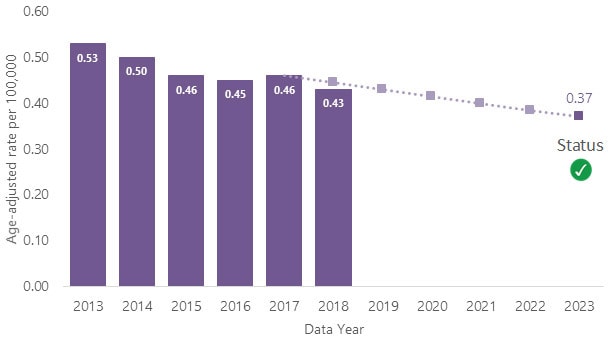National Progress Report 2025 Goal: Reduce reported rate* of hepatitis B-related deaths by ≥20%
Age-adjusted rate* of hepatitis B-related deaths†

Source: CDC, National Vital Statistics System (1)
*Rates are per 100,000 and age-adjusted to the 2000 U.S. standard population.
†Cause of death is defined as the underlying cause of death or one of the multiple causes of death and is based on the International Classification of Disease, 10th Revision (ICD-10) codes B16, B17.0, B18.0, or B18.1 (2).
Summary of Findings
Progress is being made in reducing hepatitis B-related deaths. The age-adjusted hepatitis B-related mortality rate decreased from 0.46 per 100,000 U.S. population in 2017 to 0.43 in 2018, below the 2018 target rate of 0.45.
Reduction needed to meet 2025 goal: A 14.0% reduction from the 2018 rate of hepatitis B-related deaths is needed to meet the 2025 goal of 0.37 deaths per 100,000.
This reduction can best be achieved by
- Increasing the proportion of persons tested for hepatitis B.
- Increasing the proportion of currently infected persons who are referred for care and who receive appropriate treatment.
- Developing trainings, technical assistance, and tools for primary-care and other health‑care providers to support implementation of hepatitis B testing and referral to care.
- Using digital technology and telemedicine models to expand access to specialty health‑care providers.
- Developing innovative and useful clinical decision support tools that increase implementation of hepatitis B screening, testing, and linkage to care.
- Conducting cost-benefit analyses to determine how payer policies can be revised to expand access to hepatitis B services.
- Supporting research and development for new and more effective anti-viral therapies with the goal of identifying a functional cure for hepatitis B.
Technical Notes
Data Sources: CDC, National Vital Statistics System (NVSS)
Numerator: Number of death records with a report of hepatitis B listed as the underlying or one of the multiple causes of death
Denominator: Total U.S. Census population
Indicator Notes: (1) Death certificates are completed for all deaths registered in the United States. Information for death certificates is provided to funeral directors or cremation organizations by attending physicians, medical examiners, and coroners. Death certificates are filed in vital statistics offices within each state and the District of Columbia. Through the NVSS, information from death certificates is compiled by CDC to produce national multiple-cause-of-death data; causes of death are coded in accordance with the International Classification of Diseases, Tenth Revision. (2) National multiple-cause mortality data from NVSS were obtained and analyzed, and those death records with a report of hepatitis B (ICD-10: B16, B17.0, B18.0, or B18.1) listed as the underlying or one of the multiple (e.g., contributing) causes of death in the record were enumerated. Rates were calculated as the number of deaths among U.S. residents of the 50 states and District of Columbia related to hepatitis B divided by the total U.S. Census population using the bridged-race postcensal estimates of the July 1 resident population. Rates were standardized to the age distribution of the 2000 U.S. standard population.
Goal Setting: The 2025 goal of 0.37 hepatitis B-related deaths per 100,000 U.S. population is consistent with CDC’s Division of Viral Hepatitis 2025 Strategic Plan. Annual targets assume a constant (linear) rate of change from the observed baseline (2017 data year) to the 2025 goal (2023 data year).
Limitations: Mortality data must be interpreted with caution due to the potential for misclassification of ICD-10 codes on the death record, underrepresentation of certain racial/ethnic populations in U.S. Census data and underreporting of viral hepatitis as a cause of death on death certificates.
References
- Centers for Disease Control and Prevention, National Center for Health Statistics. Multiple Cause of Death 1999-2018 on CDC WONDER Online Database, released in 2020. Data are from the Multiple Cause of Death Files, 1999-2018, as compiled from data provided by the 57 vital statistics jurisdictions through the Vital Statistics Cooperative Program. Accessed at http://wonder.cdc.gov/mcd-icd10.html on Apr 22, 2020 12:14:44 PM
- World Health Organization. International Classification of Diseases, 10th Revision. Geneva: World Health Organization; 1998. Available at: http://www.who.int/classifications/icd/en/external icon